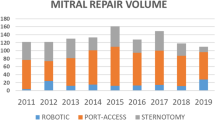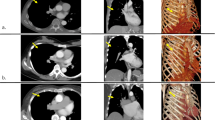Abstract
Objective
Robotically assisted mitral valve repair was approved for use in Japan in April 2018. The study objective was to assess the safety and clinical outcomes of robotic mitral valve surgery in the first 100 cases performed in our center.
Methods
We reviewed the first 100 patients who underwent robotic primary mitral valve repair, including concomitant procedures, from April 2018 to August 2019. The cause of mitral valve disease was degenerative (n = 94), endocarditis (n = 2), functional (n = 2), and other (n = 2).
Results
There was no in-hospital or 30-day mortality. Mitral valve repair was completed in all patients. Only one patient required conversion to full sternotomy due to left ventricular apex bleeding. In echocardiography performed before hospital discharge, the mitral regurgitation was graded as none or trivial in 94 patients (94%) and mild in 4 (4%). Only two patients required surgical re-intervention due to postoperative hemolysis with moderate mitral regurgitation. For patients who underwent the mitral valve procedure alone, the median times of the total operation, cardiopulmonary bypass, aortic clamping, and console usage were 185, 112, 71, and 60 min, respectively. The learning curve showed that the operation time decreased slightly during the first ten cases and then plateaued at a mean of approximately 180 min.
Conclusions
Robotically assisted mitral valve repair was feasible, safe, and therapeutically effective in the first 100 cases, with a minimal learning curve. The robotically assisted approach provides a high-quality surgical view and tremorless suture/cut handling, which will contribute to further development of minimally invasive mitral valve surgery.


Similar content being viewed by others
References
Suri RM, Dearani JA, Mihaljevic T, Chitwood WR, Murphy DA, Trento A, et al. Mitral valve repair using robotic technology: safe, effective, and durable. J Thorac Cardiovasc Surg. 2016;151:1450–4.
Murphy DA, Moss E, Binongo J, Miller JS, Macheers SK, Sarin EL, et al. The expanding role of endoscopic robotics in mitral valve surgery: 1257 consecutive procedures. Ann Thorac Surg. 2015;100:1675–81.
Suri RM, Taggarse A, Burkhart HM, Daly RC, Mauermann W, Nishimura RA, et al. Robotic mitral valve repair for simple and complex degenerative disease: mid-term clinical and echocardiographic quality outcomes. Circulation. 2015;132:1961–8.
Mihaljevic T, Koprivanac M, Kelava M, Goodman A, Jarrett C, Williams SJ, et al. Value of robotically assisted surgery for mitral valve disease. JAMA Surg. 2014;149:679–86.
Mihaljevic T, Jarrett CM, Gillinov AM, Williams SJ, DeVilliers PA, Stewart WJ, et al. Robotic repair of posterior mitral valve prolapse versus conventional approaches: potential realized. J Thorac Cardiovasc Surg. 2011;141:72–80.
Ryan WH, Brinkman WT, Dewey TM, Mack MJ, Prince SL, Herbert MA. Mitral valve surgery: comparison of outcomes in matched sternotomy and port access groups. J Heart Valve Dis. 2010;19:51–9.
Hawkins RB, Mehaffey JH, Mullen MG, Nifong WL, Chitwood WR, Katz MR, et al. A propensity matched analysis of robotic, minimally invasive, and conventional mitral valve surgery. Heart. 2018;104:1970–5.
Tarui T, Ishikawa N, Horikawa T, Seguchi R, Shigematsu S, Kiuchi R, et al. First major clinical outcomes of totally endoscopic robotic mitral valve repair in Japan- a single-center experience. Circ J. 2019;83(8):1668–733.
Gillinov AM, Mihaljevic T, Javadikasgari H, Suri RM, Mick SL, Navia JL, et al. Early results of robotically assisted mitral valve surgery: analysis of the first 1000 cases. J Thorac Cardiovasc Surg. 2018;155:82–91.
Kim HJ, Kim JB, Jung SH, Lee JW. Clinical outcomes of robotic mitral valve repair: a single-center experience in Korea. Ann Cardiothorac Surg. 2017;6(1):9–16.
Nishimura RA, Otto CM, Bonow RO, Carabello BA, Erwin JP 3rd, Fleisher LA, et al. 2017 AHA/ACC focused update of the 2014 AHA/ACC guideline for the management of patients with valvular heart disease: a report of the American College of Cardiology/American Heart Association task force on practice guidelines. Circulation. 2017;135(25):e1159–e1195195.
Kawamoto N, Fukushima S, Shimahara Y, Yamasaki T, Matsumoto Y, Yamashita K, et al. Benefit and risk of minimally invasive mitral valve repair for type II dysfunction—propensity score-matched comparison. Circ J. 2018;83:224–31.
Toya T, Fujita T, Fukushima S, Shimahara Y, Kume Y, Yamashita K, et al. Efficacy of regional saturation of oxygen monitor using near-infrared spectroscopy for lower limb ischemia during minimally invasive cardiac surgery. J Artif Organs. 2018;21(4):420–6.
Kakuta T, Fukushima S, Minami K, Shimahara Y, Yamasaki T, Matsumoto Y, et al. Contemporary outcomes of the concomitant CryoMaze procedure. Interact Cardiovasc Thorac Surg. 2019;29(1):28–34.
Kawamoto N, Fujita T, Fukushima S, Hata H, Shimahara Y, Asakura K, et al. Should annuloplasty prosthesis be selected dependent on the location of prolapse in mitral valve repair for type II dysfunction? J Thorac Cardiovasc Surg. 2017;154(6):1915–24.
Author information
Authors and Affiliations
Corresponding author
Ethics declarations
Conflict of interest
Takashi Kakuta, Satsuki Fukushima, Yusuke Shimahara, Shin Yajima, Naoki Tadokoro, Kimito Minami, Junjiro Kobayashi, and Tomoyuki Fujita have no conflicts of interest.
Additional information
Publisher's Note
Springer Nature remains neutral with regard to jurisdictional claims in published maps and institutional affiliations.
Rights and permissions
About this article
Cite this article
Kakuta, T., Fukushima, S., Shimahara, Y. et al. Early results of robotically assisted mitral valve repair in a single institution: report of the first 100 cases. Gen Thorac Cardiovasc Surg 68, 1079–1085 (2020). https://doi.org/10.1007/s11748-020-01317-2
Received:
Accepted:
Published:
Issue Date:
DOI: https://doi.org/10.1007/s11748-020-01317-2




